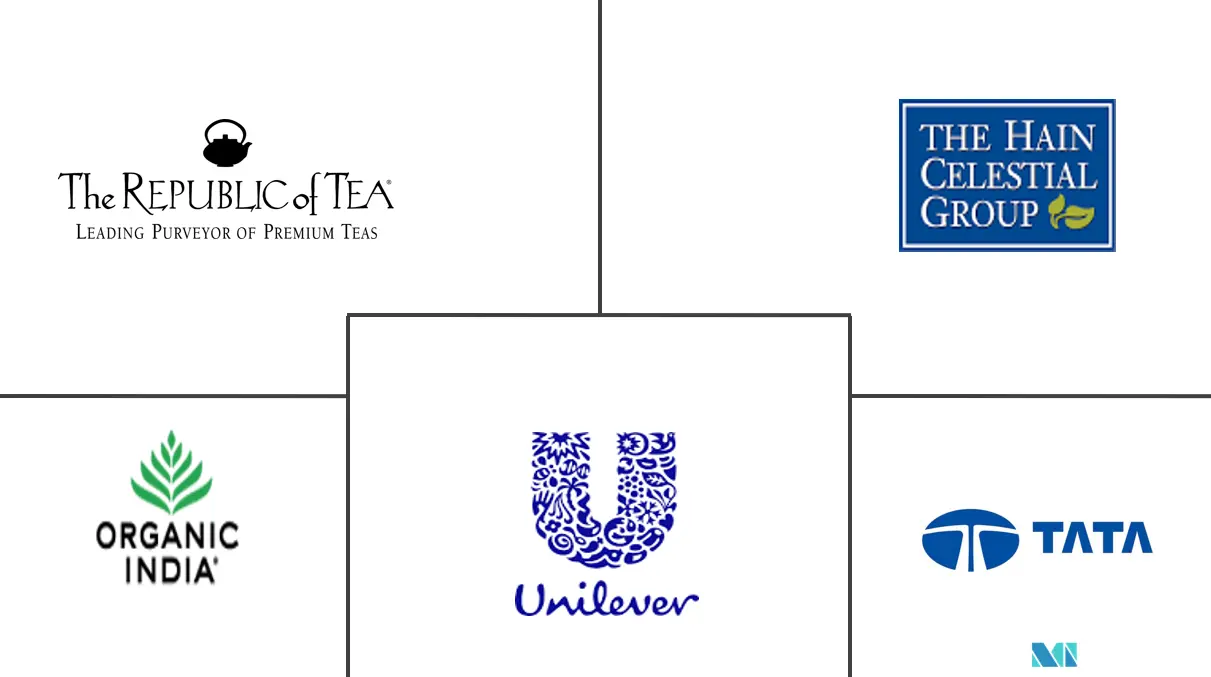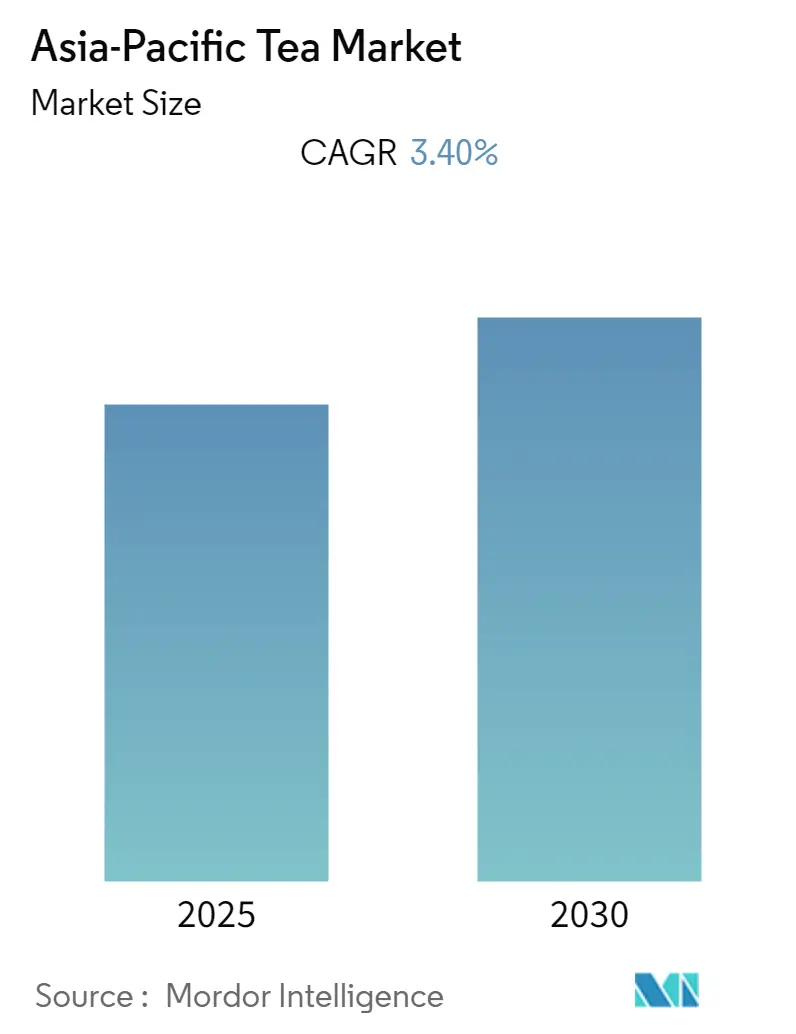
Asia-Pacific Tea Market Analysis by Mordor Intelligence
The Asia-Pacific Tea Market is expected to register a CAGR of 3.4% during the forecast period.
Tea is one of the most popular beverages in the Asia Pacific, especially in India. It is obtained from Camellia sinensis plant leaves. It offers various health benefits owing to the presence of polyphenols working as antioxidants, vitamins, trace minerals, and different amino acids resulting in stronger immunity, lower cholesterol, increased metabolism, and more. The growing inclination of demand from traditional tea to premiumization is expected to grow in the years to come. India, China, and Japan are among the top consumers of tea. The tea market is majorly driven by the health benefits associated with consuming tea and the increase in awareness related to the adverse impacts pertaining to the consumption of carbonated drinks. Moreover, the rise in disposable income, changes in the tastes of people, and the introduction of additional healthy ingredients in tea by different market players are the other factors that fuel the market growth. However, an increase in the cost of raw materials due to unpredictable weather, a rise in the cost of agricultural inputs, and an increase in the trend of coffee consumption is expected to limit the growth of the tea market.
Online retailing of organic tea products is the current profound channel for tea manufacturers, when it comes to distribution and marketing. The companies are inclining toward online stores to get better access to consumers having lack of physical outlets in remote areas. Moreover, many new startups and entrepreneurs are rather choosing this point of sale to launch their products, due to the less capital investment required and high consumer base covered.
For instance, In 2022, Luxmi Tea Company Private Ltd. scaled up operations and started selling its teas directly to consumers both through its online site, and other marketplaces and through retail stores. Moreover organic tea is also growing in the region owing to the increasing consumer awareness regarding clean-label foods such as pesticide-free commodities. The organic tea production is increasing due to the perceived higher quality along with the benefits for human wellbeing.
Asia-Pacific Tea Market Trends and Insights
Increased Exports Of Tea From Asia-Pacific Region
There is a growing trend for health consciousness among people across the globe, encouraging consumers, particularly millennials to opt for tea instead of carbonated beverages. The increase in demand for tea is due to the health benefits of tea coupled with enhanced awareness of the herbal ingredients present in it. Countries like China and India being the top producers of tea were able to meet the growing demand by exporting tea across the world. According to the Food and Agriculture Organization (FAO), China remains by far the largest tea producer, accounting for 47% of global output, reaching 3.1 million tonnes in 2021, compared to 2.9 million tonnes in 2020. Output in the second largest producer, India, recovered in 2021 to 1.33 million tonnes compared to 1.26 million tonnes in 2020.
In 2021, according to Food and Agriculture Organisation, Exports recovered slightly from the COVID-19-related downturn in 2020 to an estimated 1.8 million tonnes in 2021, owing to higher exports by Kenya and China, and resumed shipments from Sri Lanka, the second largest black tea exporter. Other major tea exporters included Sri Lanka and Kenya that year. Moreover, according to (The Food and Agriculture Organization) FAO, world tea consumption increased by 3.5% over the last decade, reflecting strong growth in producing countries that has more than offset a subdued import demand in traditional tea importing markets, namely the Russian Federation, the European Union, the United States of America and Canada. With more consumers preferring tea in the coming years, the tea market is expected to grow further during the coming years.
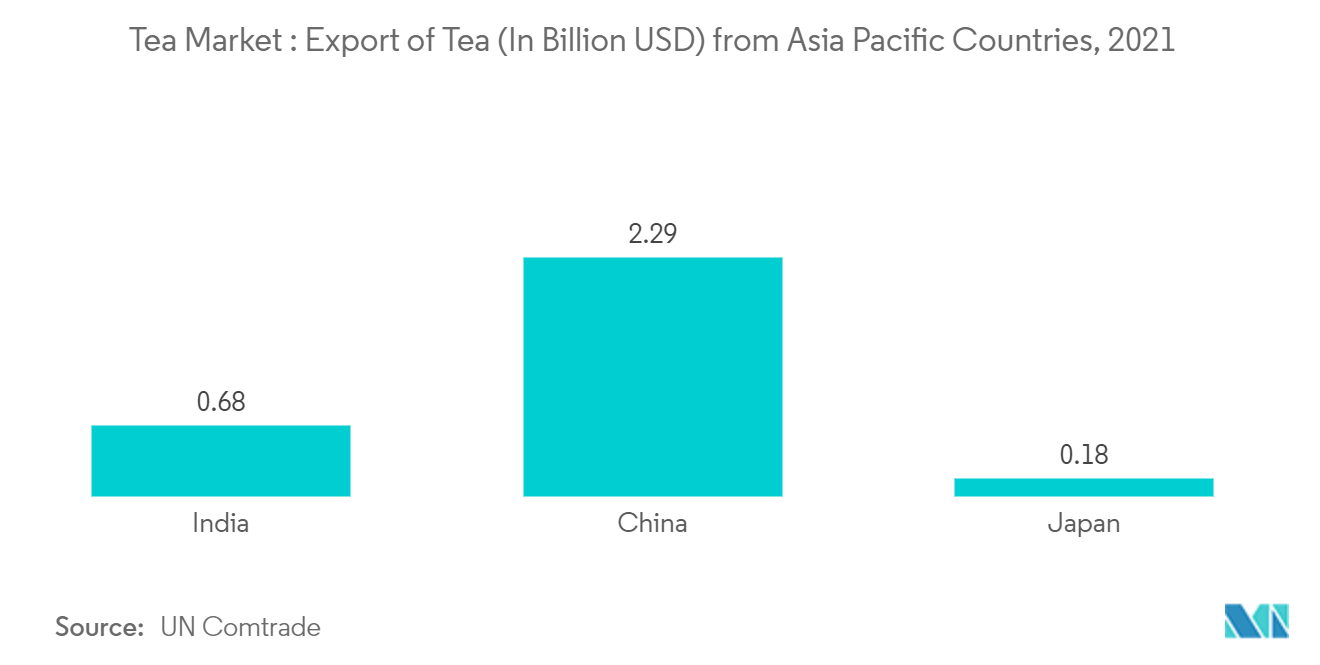
Black Tea is the Fastest Growing Segment
China, the world's top producer and the largest consumer of green tea is now exploring black tea from India, Srilanka, and China. Black tea is associated with many health benefits - it contains polyphenols which act as antioxidants that help in preventing the DNA damage caused by tobacco or other toxic chemicals. With a rise in health awareness and growing western influence, young Chinese and Japanese prefer black tea. The United Nations Food and Agriculture Organization (FAO) believes that global black tea production will grow by 2.1%, with China leading the charge in the coming years. According to IBEF (India Brand Equity Foundation), India is among the top 5 tea exporters in the world making about 10% of the total exports. In the year 2021, the total value of tea exports from India was around USD 687.9 million. The majority of the tea exported out of India is black tea makes up about 96% of the total exports. The demand for black tea is poised to grow at a faster rate due to growing consumer interest and increasing health awareness pertaining to tea consumption. Many manufacturers are offering black tea with the claims of anti-aging and other health benefits.
For instance, in September 2021, Amorepacific-owned South Korean brand Innisfree launched a new anti-aging line. It is called the Black Tea Youth Enhancing, in Singapore, following success in its home market (South Korea). The tea is claimed to be for millenials anti aging. All these factors related to health benefits of black tea are attracting consumers to buy black tea more often than other kinds of tea.
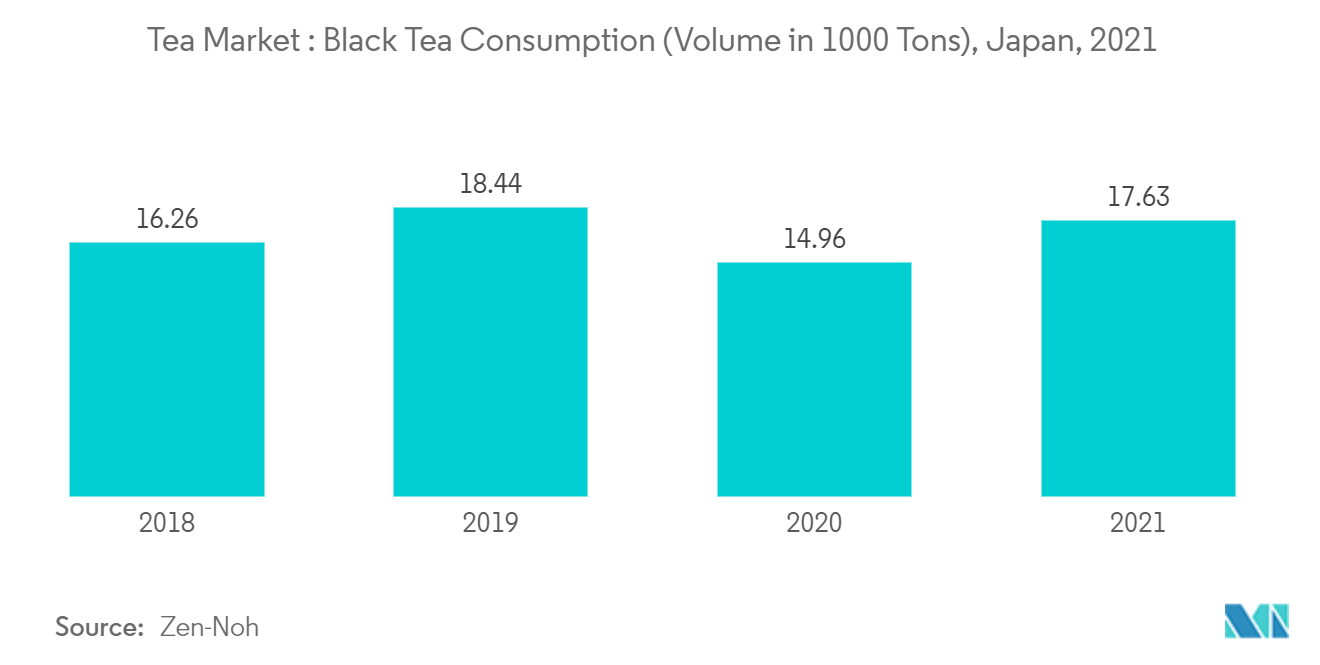
Competitive Landscape
The Asia-Pacific tea market is competitive and fragmented in nature owing to the presence of many regional and domestic players. The key players in the market include Unilever, Organic India, Tata Global Beverages, and The Hain Celestial Group, Inc. among others. The companies are adopting strategies such as mergers and acquisitions, new product innovations and launches, expansions, and partnerships to gain a prominent share in the market studied.
Asia-Pacific Tea Industry Leaders
Unilever PLC
Tata Global Beverages
The Hain Celestial Group, Inc.
The Republic of Tea
Organic India
- *Disclaimer: Major Players sorted in no particular order
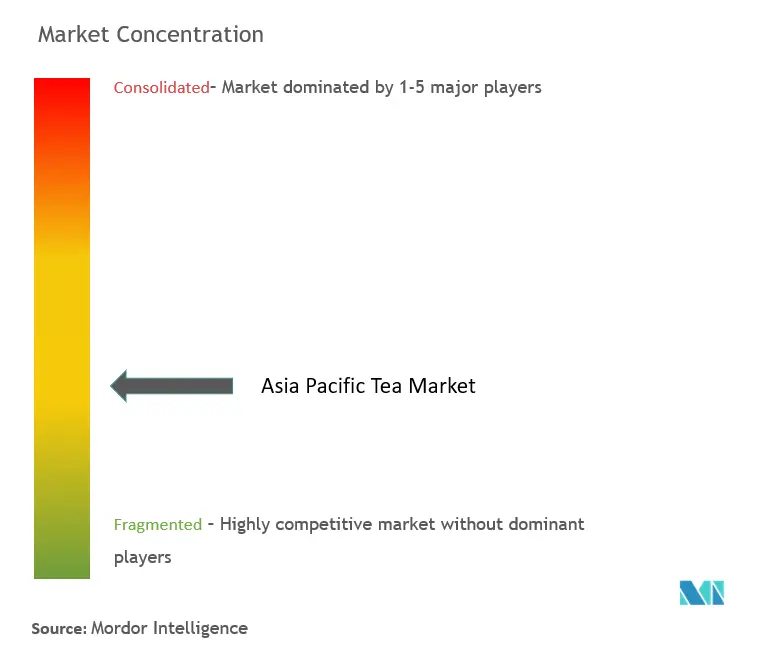
Recent Industry Developments
- In November 2022, Numi Organic Tea launched a roasted Japanese green tea line featuring small-batched processed and custom-sized whole-leaf grade organic tea sourced from Japan.
- In October 2022, Luxmi Tea Company Private Ltd.. with estates in Assam, West Bengal, Tripura, and Rwanda, Africa launched 15 new variants of tea for consumers.
- In September 2022, Dabur made its entry in the tea market with the launch of Dabur Vedic Tea, a premium category black tea under the health supplements segment,
Asia-Pacific Tea Market Report Scope
Tea is an aromatic beverage prepared by pouring hot or boiling water over cured or fresh leaves of Camellia sinensis, an evergreen shrub native to East Asia. By form, the market has been segmented into Leaf Tea and CTC Tea (Crush, Tear, Curl). By product type, the market has been segmented into Black tea, Green tea, Herbal tea, and Others. By distribution channel, the market has been segmented into Supermarkets/Hypermarkets, Convenience/Grocery Stores, Specialty Stores, Online Retail Stores, and Other Distribution Channels). Also, the study provides an analysis of the tea market in the emerging and established markets across the Asia-Pacific region, including countries such as China, Japan, India, Australia, and the Rest of Asia-Pacific. For each segment, the market sizing and forecasts have been done on the basis of value (in USD million).
| Leaf Tea |
| CTC Tea |
| Black Tea |
| Green Tea |
| Herbal Tea |
| Others |
| Supermarkets/Hypermarkets |
| Convenience/Grocery Stores |
| Specialty Stores |
| Online Retail Stores |
| Other Distribution Channels |
| China |
| Japan |
| India |
| Australia |
| Rest of Asia-Pacific |
| By Form | Leaf Tea |
| CTC Tea | |
| By Product Type | Black Tea |
| Green Tea | |
| Herbal Tea | |
| Others | |
| By Distribution Channel | Supermarkets/Hypermarkets |
| Convenience/Grocery Stores | |
| Specialty Stores | |
| Online Retail Stores | |
| Other Distribution Channels | |
| Country | China |
| Japan | |
| India | |
| Australia | |
| Rest of Asia-Pacific |
Key Questions Answered in the Report
What is the current Asia-Pacific Tea Market size?
The Asia-Pacific Tea Market is projected to register a CAGR of 3.4% during the forecast period (2025-2030)
Who are the key players in Asia-Pacific Tea Market?
Unilever PLC, Tata Global Beverages, The Hain Celestial Group, Inc., The Republic of Tea and Organic India are the major companies operating in the Asia-Pacific Tea Market.
What years does this Asia-Pacific Tea Market cover?
The report covers the Asia-Pacific Tea Market historical market size for years: 2019, 2020, 2021, 2022, 2023 and 2024. The report also forecasts the Asia-Pacific Tea Market size for years: 2025, 2026, 2027, 2028, 2029 and 2030.
Page last updated on:
Asia-Pacific Tea Market Report
Statistics for the 2025 Asia-Pacific Tea market share, size and revenue growth rate, created by Mordor Intelligence™ Industry Reports. Asia-Pacific Tea analysis includes a market forecast outlook for 2025 to 2030 and historical overview. Get a sample of this industry analysis as a free report PDF download.
